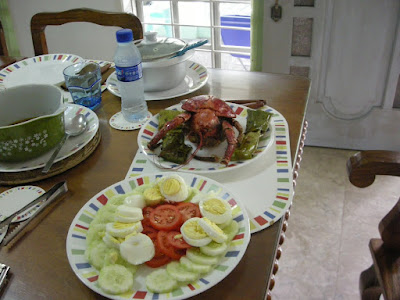My Lunch of Coconut Crab served with Cucumber-Tomatoes Salad, at Chateau Du Mer, Boac, Marinduque, Philippines, May, 2017
The coconut crab, locally known as Tatus (Birgus latro)., holds the title of the largest land-dwelling arthropod in the world. Adult coconut crabs can exceed 4 kg in weight and boast a leg span of over 3 feet. Remarkably, they are among the longest-living arthropods, with a lifespan that can stretch up to 60 years. This species is found across areas in the Indian and Pacific Oceans. In the Philippines they are scattered across islands and coral atolls from Luzon to Mindanao.
Considered a delicacy in the islands of Batanes and Caluya, Antique, locals and tourists alike seek the edible, savory-sweet flesh and creamy fat. It is often cooked as escabeche, with coconut milk, or simply boiled. Tatus are typically found in coastal lands, rocky shorelines, and cliffs. They feed on fruits, seeds, nuts (including coconuts), and occasionally, plant and animal remains. Their slow-moving nature makes them easy to catch, even by bare hands.
The urbanization of coastal areas, driven by a growing human population and overharvesting of the species, has led to its extirpation or local extinction in many parts of the world. In Caluya, it is illegal to catch the species within the municipality except during the Tatusan festival.
The coconut crab has been declared a threatened species by the Department of Agriculture, as per Fisheries Administrative Order No. 208. Additionally, the species is listed as vulnerable by the International Union for Conservation of Nature (IUCN) due to habitat conversion and fragmentation, as well as direct exploitation for human consumption. For Details visit:
Meanwhile, I have some fairly good news of Life here at THD: Chairs at the Activity Room:
Yesterday after dinner I had a chance to chat with Rachel Ryan, THD Chief Financial Officer, regarding the Chairs at the new Activity Room. I told her that a few of THD residents including myself felt that the back of the chair is not comfortable so that after seating for 30 minutes, most of the seniors complain of back ache. Rachel said she is thinking about the problem. I suggested a back pad be installed on the chairs and maybe add more padding on the seats. Let us hope a solution will be coming soon. Barbara and Jenny were witnessed to the above conversion with our CFO who has the final decision of items that required money. Thank you, Rachel for listening!




No comments:
Post a Comment